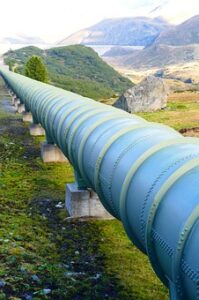 FBG sensors give the opportunity to measure a variety of parameters in conditions where other sensor technologies fail or simply cannot operate. Such FBG sensors have intrinsic advantages, including resistance to electromagnetic interference, non-electrical conductivity, passive measurements, small size and small weight, and the option of multipoint measurements. the reflection wavelength of the FBG (Bragg wavelength) depends on the grating characteristics (period, modulation) and is influenced by the ambient conditions such as strain and temperature. The development of fiber optic devices based on fiber optic sensors for operation in harsh environments (such as for temperatures of up to 1000°С) is becoming an increasingly important field. In the case of temperature sensing the Bragg wavelength is a function of the temperature. This temperature dependence results from changes in the refractive index of the fiber as well as from thermal expansion of the glass material. Many material properties show strong temperature dependence. Examples of such temperature dependencies are dew point, density, electrical conductivity, refractive index, rigidity, and diffusion. Temperature measurement also plays an important role in the health monitoring of electric circuits or civil structures.
FBG sensors give the opportunity to measure a variety of parameters in conditions where other sensor technologies fail or simply cannot operate. Such FBG sensors have intrinsic advantages, including resistance to electromagnetic interference, non-electrical conductivity, passive measurements, small size and small weight, and the option of multipoint measurements. the reflection wavelength of the FBG (Bragg wavelength) depends on the grating characteristics (period, modulation) and is influenced by the ambient conditions such as strain and temperature. The development of fiber optic devices based on fiber optic sensors for operation in harsh environments (such as for temperatures of up to 1000°С) is becoming an increasingly important field. In the case of temperature sensing the Bragg wavelength is a function of the temperature. This temperature dependence results from changes in the refractive index of the fiber as well as from thermal expansion of the glass material. Many material properties show strong temperature dependence. Examples of such temperature dependencies are dew point, density, electrical conductivity, refractive index, rigidity, and diffusion. Temperature measurement also plays an important role in the health monitoring of electric circuits or civil structures.
The main advantages of FBG sensors are their measurement of reflected light, wavelength-encoded sensing, and multiplexing capability. Nowadays there are many types of FBG sensors used for measuring temperature: intrinsic and extrinsic.
Three major types exist:
- The intensity-modulated sensors
Intensity-modulated FBG sensors are based on the principle of letting a physical disturbance such as temperature cause a change in the received light through an optical fiber;
- The phase-modulated sensors
The phase-modulated FBG sensors are based on the principle of comparing the phase of light in the sensing fiber with a reference fiber in an interferometer;
- The wavelength modulated sensors
Wavelength modulated FBG sensors are based on the principle that a physical disturbance such as temperature or strain changes the reflected wavelength of the light.
In general, it should be noted, phase modulated and wave modulated FBG sensors are providing much more accurate measurements than intensity-modulated sensors but at the cost of much more expensive interrogators.
Optromix, Inc. is a U.S. manufacturer of innovative fiber optic products for the global market, based in Cambridge, MA. Our team always strives to provide the most technologically advanced fiber optic solutions for our clients. Our main goal is to deliver the best quality fiber optic products to our clients. We produce a wide range of fiber optic devices, including our cutting-edge customized fiber optic Bragg grating product line and fiber Bragg grating sensor systems. Optromix, Inc. is a top choice among the manufacturers of fiber Bragg grating monitoring systems. If you have any questions, please contact us at info@optromix.com


 Fiber optic devices
Fiber optic devices Aircraft structures require regular, scheduled inspections and monitoring of all possible hazards due to their special conditions and the principles of their design. Therefore, structural health monitoring is conducted through
Aircraft structures require regular, scheduled inspections and monitoring of all possible hazards due to their special conditions and the principles of their design. Therefore, structural health monitoring is conducted through  A traditional way of monitoring structural health is through the use of piezoelectric transducers; these devices convert pressure to an electric voltage. Transducers are reliable and accurate in most working conditions except in cases of corrosive environments or under high temperatures, above 300° Celsius. Harsh conditions influence reliability. accuracy, and usefulness of transducers in a negative way.
A traditional way of monitoring structural health is through the use of piezoelectric transducers; these devices convert pressure to an electric voltage. Transducers are reliable and accurate in most working conditions except in cases of corrosive environments or under high temperatures, above 300° Celsius. Harsh conditions influence reliability. accuracy, and usefulness of transducers in a negative way. The demand for data is growing exponentially, piling pressure on networks to deliver more data, faster, over longer distances.
The demand for data is growing exponentially, piling pressure on networks to deliver more data, faster, over longer distances.  Recent events in the nuclear industry have shown the weaknesses in the control of the critical systems that ensure the safety of the nuclear plant. The extreme and accidental conditions, such as high temperatures and high levels of radiation sabotage the security of nuclear power plants, leading to major disasters. The main issue for the nuclear industry is to enhance the security of existing nuclear power plants and improve the design of the future ones. In the case of emergency or accidental conditions in nuclear reactors the following thermodynamic parameters need to be known in order to facilitate appropriate actions: temperature, pressure, water level, radiation level. The accuracy of the obtained information directly influences the decisions made by the operators. The monitoring instruments used inside the nuclear fuel pools need to better withstand severe conditions that occur during malfunctions and accidents, namely high temperatures and high levels of radiation. The strict safety regulations have pushed the fiber optic market to develop sensors based on optical fibers. Optical fiber sensors, like
Recent events in the nuclear industry have shown the weaknesses in the control of the critical systems that ensure the safety of the nuclear plant. The extreme and accidental conditions, such as high temperatures and high levels of radiation sabotage the security of nuclear power plants, leading to major disasters. The main issue for the nuclear industry is to enhance the security of existing nuclear power plants and improve the design of the future ones. In the case of emergency or accidental conditions in nuclear reactors the following thermodynamic parameters need to be known in order to facilitate appropriate actions: temperature, pressure, water level, radiation level. The accuracy of the obtained information directly influences the decisions made by the operators. The monitoring instruments used inside the nuclear fuel pools need to better withstand severe conditions that occur during malfunctions and accidents, namely high temperatures and high levels of radiation. The strict safety regulations have pushed the fiber optic market to develop sensors based on optical fibers. Optical fiber sensors, like